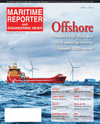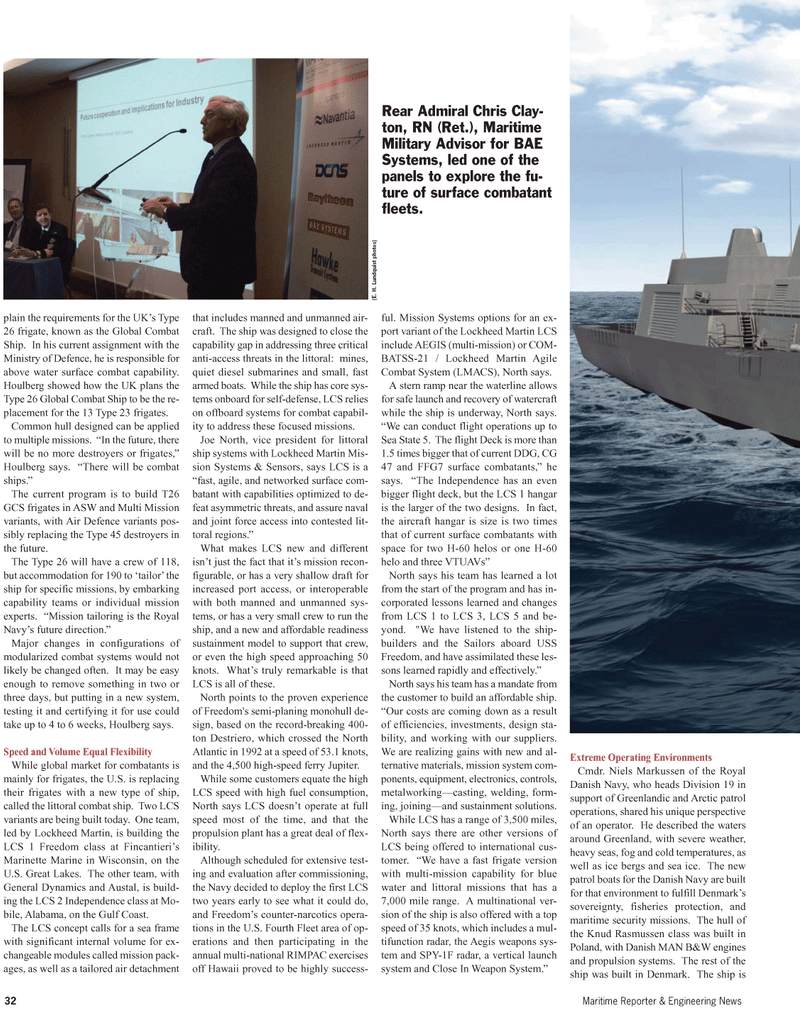
Page 32: of Maritime Reporter Magazine (April 2012)
Offshore Deepwater Annual
Read this page in Pdf, Flash or Html5 edition of April 2012 Maritime Reporter Magazine
plain the requirements for the UKs Type 26 frigate, known as the Global Combat Ship. In his current assignment with the Ministry of Defence, he is responsible forabove water surface combat capability. Houlberg showed how the UK plans the Type 26 Global Combat Ship to be the re- placement for the 13 Type 23 frigates. Common hull designed can be appliedto multiple missions. In the future, there will be no more destroyers or frigates,? Houlberg says. There will be combat ships.? The current program is to build T26 GCS frigates in ASW and Multi Mission variants, with Air Defence variants pos- sibly replacing the Type 45 destroyers in the future.The Type 26 will have a crew of 118, but accommodation for 190 to tailor the ship for specific missions, by embarking capability teams or individual mission experts. Mission tailoring is the Royal Navys future direction.? Major changes in configurations of modularized combat systems would not likely be changed often. It may be easy enough to remove something in two or three days, but putting in a new system, testing it and certifying it for use couldtake up to 4 to 6 weeks, Houlberg says. Speed and Volume Equal Flexibility While global market for combatants is mainly for frigates, the U.S. is replacing their frigates with a new type of ship, called the littoral combat ship. Two LCS variants are being built today. One team, led by Lockheed Martin, is building the LCS 1 Freedom class at Fincantieris Marinette Marine in Wisconsin, on the U.S. Great Lakes. The other team, with General Dynamics and Austal, is build- ing the LCS 2 Independence class at Mo-bile, Alabama, on the Gulf Coast. The LCS concept calls for a sea framewith significant internal volume for ex- changeable modules called mission pack-ages, as well as a tailored air detachmentthat includes manned and unmanned air- craft. The ship was designed to close the capability gap in addressing three critical anti-access threats in the littoral: mines, quiet diesel submarines and small, fast armed boats. While the ship has core sys- tems onboard for self-defense, LCS relieson offboard systems for combat capabil- ity to address these focused missions.Joe North, vice president for littoralship systems with Lockheed Martin Mis-sion Systems & Sensors, says LCS is afast, agile, and networked surface com- batant with capabilities optimized to de-feat asymmetric threats, and assure naval and joint force access into contested lit-toral regions.? What makes LCS new and different isnt just the fact that its mission recon- figurable, or has a very shallow draft for increased port access, or interoperablewith both manned and unmanned sys-tems, or has a very small crew to run the ship, and a new and affordable readiness sustainment model to support that crew, or even the high speed approaching 50 knots. Whats truly remarkable is that LCS is all of these.North points to the proven experience of Freedom's semi-planing monohull de-sign, based on the record-breaking 400-ton Destriero, which crossed the NorthAtlantic in 1992 at a speed of 53.1 knots,and the 4,500 high-speed ferry Jupiter. While some customers equate the highLCS speed with high fuel consumption,North says LCS doesnt operate at full speed most of the time, and that thepropulsion plant has a great deal of flex- ibility. Although scheduled for extensive test- ing and evaluation after commissioning, the Navy decided to deploy the first LCS two years early to see what it could do, and Freedoms counter-narcotics opera- tions in the U.S. Fourth Fleet area of op- erations and then participating in theannual multi-national RIMPAC exercises off Hawaii proved to be highly success- ful. Mission Systems options for an ex- port variant of the Lockheed Martin LCS include AEGIS (multi-mission) or COM- BATSS-21 / Lockheed Martin Agile Combat System (LMACS), North says. A stern ramp near the waterline allows for safe launch and recovery of watercraft while the ship is underway, North says. We can conduct flight operations up to Sea State 5. The flight Deck is more than 1.5 times bigger that of current DDG, CG47 and FFG7 surface combatants,? he says. The Independence has an even bigger flight deck, but the LCS 1 hangar is the larger of the two designs. In fact, the aircraft hangar is size is two times that of current surface combatants with space for two H-60 helos or one H-60 helo and three VTUAVs? North says his team has learned a lotfrom the start of the program and has in-corporated lessons learned and changesfrom LCS 1 to LCS 3, LCS 5 and be-yond. "We have listened to the ship- builders and the Sailors aboard USS Freedom, and have assimilated these les- sons learned rapidly and effectively.? North says his team has a mandate fromthe customer to build an affordable ship. Our costs are coming down as a result of efficiencies, investments, design sta- bility, and working with our suppliers. We are realizing gains with new and al- ternative materials, mission system com- ponents, equipment, electronics, controls,metalworking?casting, welding, form- ing, joining?and sustainment solutions.While LCS has a range of 3,500 miles,North says there are other versions of LCS being offered to international cus- tomer. We have a fast frigate version with multi-mission capability for bluewater and littoral missions that has a 7,000 mile range. A multinational ver- sion of the ship is also offered with a top speed of 35 knots, which includes a mul-tifunction radar, the Aegis weapons sys- tem and SPY-1F radar, a vertical launch system and Close In Weapon System.? Extreme Operating Environments Cmdr. Niels Markussen of the Royal Danish Navy, who heads Division 19 in support of Greenlandic and Arctic patrol operations, shared his unique perspective of an operator. He described the waters around Greenland, with severe weather, heavy seas, fog and cold temperatures, as well as ice bergs and sea ice. The new patrol boats for the Danish Navy are built for that environment to fulfill Denmarks sovereignty, fisheries protection, and maritime security missions. The hull of the Knud Rasmussen class was built in Poland, with Danish MAN B&W enginesand propulsion systems. The rest of the ship was built in Denmark. The ship is 32Maritime Reporter & Engineering News Rear Admiral Chris Clay-ton, RN (Ret.), MaritimeMilitary Advisor for BAESystems, led one of thepanels to explore the fu- ture of surface combatant fleets. (E. H. Lundquist photos)

 31
31

 33
33
